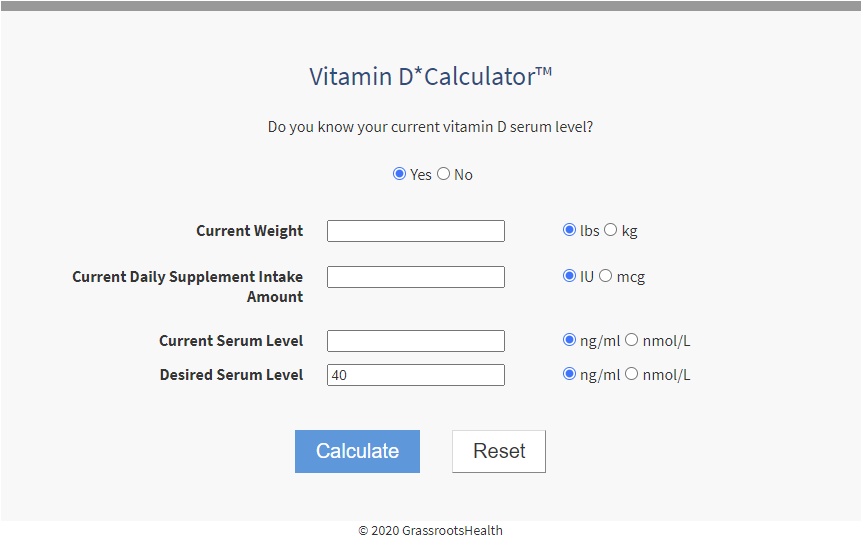Published on July 31, 2020
Key Points
- The updated GrassrootsHealth Vitamin D*calculator calculates a customized loading dose to help an individual reach their chosen target vitamin D level more rapidly (based on body weight and starting vitamin D level) allowing you to reach your target level within days instead of over three months
- This “loading dose” is an option for participants with vitamin D levels that are known to be much lower than desired, or for those who are needing to raise levels quickly due to a health condition or health concern (such as boosting the immune system)
- The “maintenance dose” calculates the estimated daily amount of vitamin D intake required to maintain the desired vitamin D level – this is in addition to current intake from food and the sun
The D*calculator provides two options for increasing your vitamin D levels – a “Loading Dose” and a “Maintenance Dose” allowing users to choose how quickly they would like to achieve their desired levels.
What’s New?
1. The “Loading Dose”
The updated GrassrootsHealth Vitamin D*calculator calculates a customized loading dose to help an individual reach their chosen target vitamin D level more rapidly (based on body weight and starting vitamin D level) allowing you to reach your target level within days instead of over three months.
The calculation for the loading dose is based on the formula published by van Groningen et al (2010) as follows: Vitamin D Loading dose (IU) = 45 multiplied by the desired rise in vitamin D level (target vitamin D level – starting vitamin D level in ng/mL) multiplied by body weight in pounds.
This “loading dose” is given as an option to help achieve a target level within days, versus using only the maintenance dose, which reaches the target within months. It is an option for participants with vitamin D levels that are known to be much lower than desired, or for those who are needing to raise levels quickly due to a health condition or health concern (such as boosting the immune system).
Hundreds of peer-reviewed scientific studies have documented the well-established safety of single loading doses of vitamin D to get levels up quickly. Loading doses ranging from 100,000 IU to 600,000 IU have been shown to rapidly increase vitamin D levels, but fail to sustain levels longer than 2-3 months. Larger doses induce more rapid breakdown of vitamin D, and therefore, the customized loading dose given by the new D*calculator is divided into doses of 25,000 IU over a number of days to achieve the initial increase in vitamin D level. The maintenance dose can then be taken on a daily basis to help maintain the achieved level.
2. The “Maintenance Dose”
The “maintenance dose” calculates the estimated amount of vitamin D intake required to maintain the desired vitamin D level – this is in addition to current intake from food and the sun. The maintenance dose will gradually increase vitamin D levels to achieve the desired target over approximately three months.
We have capped the calculated daily vitamin D intake at 10,000 IU per day to match the No Observed Adverse Effect Level (NOAEL).
3. Estimate for those without a Starting Vitamin D Level
Don’t know your current level? Now the D*calculator can suggest a daily vitamin D intake for individuals who enter only their weight and target vitamin D level. This calculation is an estimate based on the average intake required for people of the same body weight. The loading dose will not be calculated for this option, as a safety measure without knowing the current vitamin D level.
We strongly encourage everyone to test their vitamin D level, since it is important to know the current level for a more accurate calculation of what supplement dose could help achieve a target level. However, not everyone has immediate access to their vitamin D level, so, this calculation is a next best option for an educated decision on how much to take on a daily basis.
4. Current Intake Included with Calculation
Previously, the D*calculator asked individuals to add the calculated suggested intake to any current intake (as their additional daily intake amount). To make it easier for users, the current daily supplement intake amount can be entered as part of the calculation and included in the result as the estimated total supplemental intake needed per day to achieve the desired target level.
5. Additional Options for Units of Measure
GrassrootsHealth has participants from all over the globe and different countries use different units of measurement. To increase ease of use, we have made one final improvement to the new D*calculator (which many of our followers had been asking for), and added options for:
- Pounds or kilograms when entering weight
- IU or mcg when entering current vitamin D intake and when given the resulting calculation
- ng/ml or nmol/L for the starting and target vitamin D levels
What Hasn’t Changed
 The original GrassrootsHealth Vitamin D*calculator was published in 2015 as a tool to help individuals calculate the estimated additional Vitamin D intake (beyond their current intake from food, sun and supplements) needed to reach a target vitamin D level. The level to target, based on a consensus of 48 international vitamin D researchers and scientists, is 40-60 ng/ml, or 100-150 nmol/L; however, individuals using the calculator are given the opportunity to enter a target level of their choosing. The calculation is also based on the starting vitamin D level and body weight.
The original GrassrootsHealth Vitamin D*calculator was published in 2015 as a tool to help individuals calculate the estimated additional Vitamin D intake (beyond their current intake from food, sun and supplements) needed to reach a target vitamin D level. The level to target, based on a consensus of 48 international vitamin D researchers and scientists, is 40-60 ng/ml, or 100-150 nmol/L; however, individuals using the calculator are given the opportunity to enter a target level of their choosing. The calculation is also based on the starting vitamin D level and body weight.
The calculator was developed using GrassrootsHealth data, and calculates two different approximate dose amounts to take on a daily basis, in addition to current dose/intake: one amount that would get approximately 50% of individuals to their chosen target level, and another that would get approximately 90% of individuals to their chosen target level. Whichever amount an individual chooses to use daily to help achieve and maintain their desired vitamin D level would be called their “maintenance dose.” The target vitamin D level achieved using only this dose would generally be reached within approximately 3 months of supplementation.
Try the NEW D*calculator Today!
Discover how much vitamin D may be necessary to help you achieve your target vitamin D level. Are you getting enough vitamin D? Test today to find out – and use the D*calculator to make any necessary adjustments, then re-test to see if it’s working for you!
Are You Getting Enough Vitamin D to Help Yourself?
Do you know what your vitamin D level is? Be sure to test today to find out, and take steps to keep it within a target of 40-60 ng/ml or 100-150 nmol/L! Give your immune system the nutrients it needs to support a healthy you and protect yourself from unnecessary diseases.
Through GrassrootsHealth Nutrient Research Institute, you can also test your essential elements magnesium, copper, zinc and selenium, toxins such as lead, mercury and cadmium, as well as your omega-3 levels, inflammation levels and thyroid stimulating hormone (TSH) level. Find out your levels today! Log on to the test selection page (click the link below) to get your tests and see for yourself if your levels can be improved.
Make sure you track your results before and after, about every 6 months! Click Here to Access the Test Page
How can I track my nutrient intake and levels over time?
To help you track your supplement use and nutrient levels, GrassrootsHealth has created the Personal Health Nutrient Decision System called
For each specific supplement, you can track what days you take it, how much, and many other details. This will help you know your true supplemental intake and what patterns of use work for you to reach and maintain optimum nutrient levels. Check it out today!








